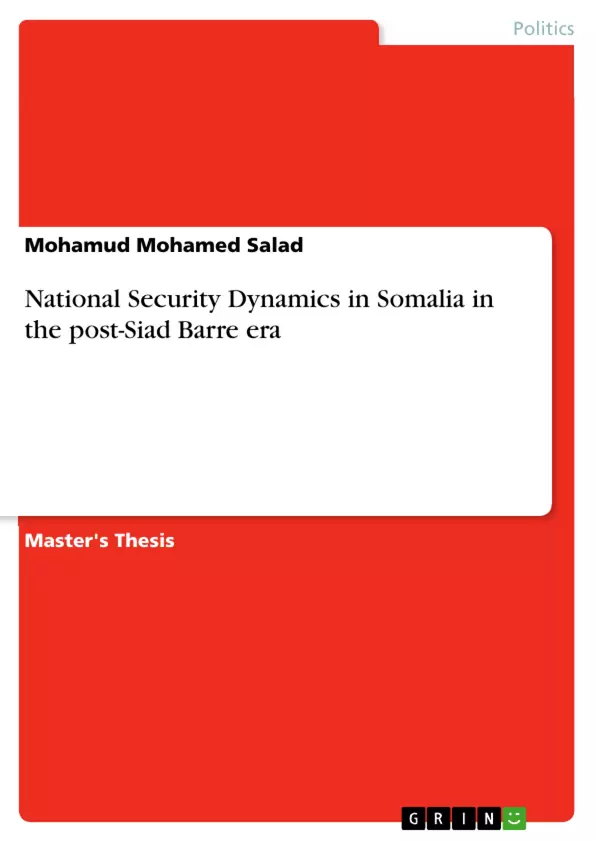Somalia was one of the first states to crumble in the post-cold war era. This study seeks to explain the destruction of the Somali state from a security perspective, arguing that a plethora of factors including the political economy of class and regional dynamics underscored the dissolution of the Somali nation-state and that the emergence of political Islam to fill the political vacuum configured the pattern of security challenges facing the country. In doing so, this study utilizes the qualitative research design premised on the interview technique as the main data collection method.
What is clear from this study is that to explain the destruction of Somalia and its security abyss we must probe deeper to uncover the points of fracture of the Somali social order, as well as external factors obscured by an emphasis on clan tensions by media and scholarly reportage. Hence, explaining Somalia’s dissolution and its attendant security challenges is a contribution to the ongoing project of theorizing the global disintegration of nation-states in the post-Cold War era. All things considered, it is hoped that this study will provide professionals and scholars insights on the challenges of African security in the Twenty-First century.
Inhaltsverzeichnis (Table of Contents)
- Introduction
- The Somali State: Its Genesis, Evolution, and Collapse
- The Colonial Era
- The Siad Barre Regime
- The Collapse of the State
- Security Challenges in Somalia
- Clan Violence and Conflict
- The Rise of Political Islam
- Terrorism and Piracy
- Humanitarian Crisis and Famine
- The International Response to Somalia
- UN Peacekeeping Operations
- The African Union Mission in Somalia (AMISOM)
- Bilateral and Multilateral Aid
- The Future of Somalia
- The Role of the Federal Government
- Reconciliation and National Dialogue
- Economic Development and Security Sector Reform
Zielsetzung und Themenschwerpunkte (Objectives and Key Themes)
This dissertation examines the destruction of the Somali state from a security perspective, focusing on the interplay of political, economic, and social factors that contributed to its collapse. It analyzes the emergence of political Islam as a key player in the post-Siad Barre era and its impact on security challenges.
- The political economy of class and regional dynamics in Somalia
- The role of political Islam in the post-Siad Barre era
- The impact of clan tensions and violence on state security
- The international response to Somalia's security challenges
- The prospects for state-building and peace in Somalia
Zusammenfassung der Kapitel (Chapter Summaries)
- Chapter 1: Introduction - This chapter provides an overview of the research topic, its significance, and the theoretical framework employed.
- Chapter 2: The Somali State: Its Genesis, Evolution, and Collapse - This chapter traces the historical evolution of the Somali state, examining its colonial legacy, the Siad Barre regime, and the events leading to its collapse.
- Chapter 3: Security Challenges in Somalia - This chapter analyzes the various security challenges facing Somalia, including clan violence, the rise of political Islam, terrorism, piracy, and humanitarian crises.
- Chapter 4: The International Response to Somalia - This chapter examines the role of international actors in addressing Somalia's security challenges, including UN peacekeeping operations, AMISOM, and bilateral and multilateral aid.
- Chapter 5: The Future of Somalia - This chapter explores potential pathways for state-building and peace in Somalia, focusing on the role of the federal government, reconciliation and national dialogue, economic development, and security sector reform.
Schlüsselwörter (Keywords)
This dissertation focuses on key concepts like clan tension, violence, famine, nation-state, security challenges, political Islam, and Somalia, highlighting the complex interplay of these factors in the context of state collapse and ongoing instability.
- Citation du texte
- Mr. Mohamud Mohamed Salad (Auteur), 2016, National Security Dynamics in Somalia in the post-Siad Barre era, Munich, GRIN Verlag, https://www.grin.com/document/367480



